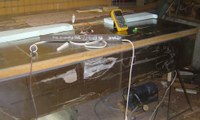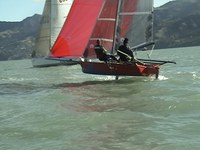Hydrofoil Project Notes - June 2009
Getting there.
Before we could get started on the prepreg foils we ne eded to finish setting up the oven. We wanted an oven capable of sustaining a reliable vacuum with stable and even heat. It also needed to be robust enough to last for the planned sets of foils as well as future projects. The outside of the oven is made from insulated metal panels, with a vacuum table about halfway up. A layer of heating cable (1.5m2) is on a raised mesh halfway between the base of the oven and the vacuum table. 4 high volume fans circulate the air to ensure even heating. The bag is attached to a metal rectangle the size of the table with foam on the bottom outer edge. We use small clamps to hold the edge down and compress the foam enough to get the vacuum started. Initially we used 4 sensors to monitor temperatures around the oven and verify the controller stayed on target. As the ramp up is pretty even and once at target the temperature is very stable we now just use a single sensor as a check on the controller.
eded to finish setting up the oven. We wanted an oven capable of sustaining a reliable vacuum with stable and even heat. It also needed to be robust enough to last for the planned sets of foils as well as future projects. The outside of the oven is made from insulated metal panels, with a vacuum table about halfway up. A layer of heating cable (1.5m2) is on a raised mesh halfway between the base of the oven and the vacuum table. 4 high volume fans circulate the air to ensure even heating. The bag is attached to a metal rectangle the size of the table with foam on the bottom outer edge. We use small clamps to hold the edge down and compress the foam enough to get the vacuum started. Initially we used 4 sensors to monitor temperatures around the oven and verify the controller stayed on target. As the ramp up is pretty even and once at target the temperature is very stable we now just use a single sensor as a check on the controller.
TheVirtual foils.
The second set of foils have a few changes. We made the verticals 150mm longer. We've added a couple of degrees extra rake to the main foil and raked the rudder forwards to reduce the helm when heeled to windward.  We launched the foils at the start of May. The conditions were pretty light. At first we tried a fairly flexible wand, but it was a bit too flexible in such light conditions. So we swapped in the other wand we were carrying which went much better. We've made a couple of longer wands now and fixed a minor setup issue which meant we weren't getting as much flap movement as we expected from onshore tests. The boat foiled reasonably well, considering how little down flap movement we had, but definitely wasn't foiling as early or easily as L3 does in the same conditions. The setup issue was easily addressable, just not on the water.
We launched the foils at the start of May. The conditions were pretty light. At first we tried a fairly flexible wand, but it was a bit too flexible in such light conditions. So we swapped in the other wand we were carrying which went much better. We've made a couple of longer wands now and fixed a minor setup issue which meant we weren't getting as much flap movement as we expected from onshore tests. The boat foiled reasonably well, considering how little down flap movement we had, but definitely wasn't foiling as early or easily as L3 does in the same conditions. The setup issue was easily addressable, just not on the water.
Due to gales each weekend we were unable to sail again until the 30th of May, unfortunately it was pretty light. The forecast was for 10kts and looked like it might build. We setup the main foil with a higher angle of attack and ventured out. The breeze never got over 4kts so we didn't manage to get up on the foils, the boat did lift with the kite, but couldn't quite break free. We did try single handing it towards the end, but the breeze was dropping off and it didn't help. Even though the breeze was lighter than the first time out the foils were setup much better and the boat was definitely lifting earlier and felt better. Unfortunately there just wasn't enough breeze to get airborne. We were actually wanting to do testing in more breeze and would have preferred to have waited for a more promising day, however as its probably the last chance before next season we thought it was worth venturing out.
Until now we've really been more interested in just getting out and foiling rather than worrying finishing off the foils. Sean and Dan's foils have been undercoated. Ours have just had the T joints filled and roughly faired and a quick skim fill and rough sand over the rest of the foil surface. Its certainly good enough for the testing we've been doing so far. Over winter we'll tidy up the foils and get them to a race ready finish.
David Pairman (Merde) has spent quite a lot of time coming up with a set of neat case plugins to retrofit foils to boats where the case structure is very lightweight and not designed for vertical loads. The vertical load is transferred through to the outer hull at the base of the case. They probably won't now sail till the start of next season though.
In foiling conditions the foiling boats are clearly faster around the course than the non foiling boats. In sub foiling conditions (with the wand disconnected) the boats with foils are marginally slower to windward. They are faster downwind, even when not quite foiling, as you can use the foils to get better depth at about the same speed.
